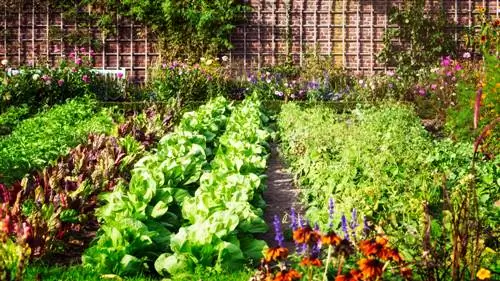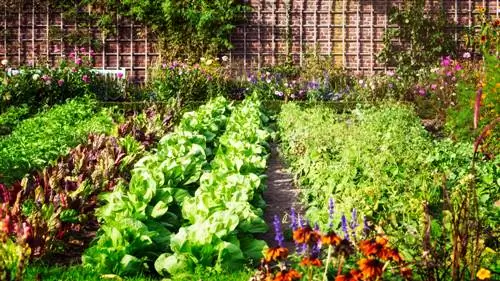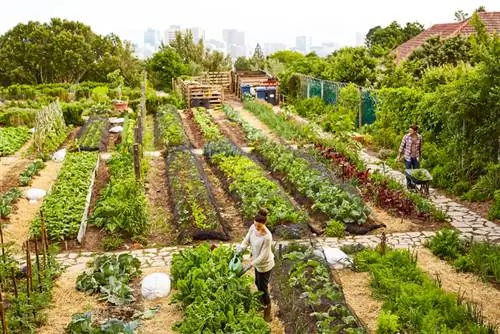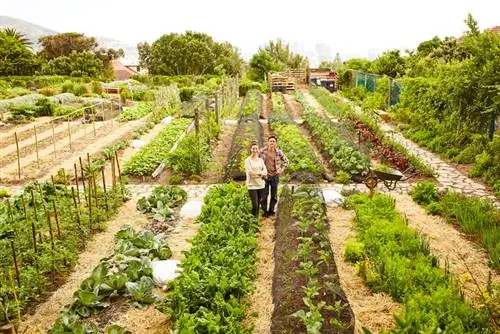- Author admin [email protected].
- Public 2023-12-16 16:46.
- Last modified 2025-01-23 11:21.
Growing vegetables in your own garden, but also vegetable beds on the balcony, are gaining more and more fans. Through clever cultivation planning, even relatively small bed areas can be used optimally. If you also pay attention to which plant neighbors get along well, you can almost always do without chemical pesticides.

How can a vegetable patch be divided as an example?
A good example of a vegetable patch is the division into heavy feeders (celery, leeks, cabbage), medium feeders (carrots, fennel, onions, lettuces, radishes), weak feeders (peas, beans, herbs) and soil-supporting plants (buckwheat, Phacelia). The correct arrangement promotes plant growth and reduces pest infestation.
Examples of correct classification
If you follow the old cultivation rule of dividing the area of the vegetable garden into four areas, you will save yourself a lot of planning work when it comes to crop rotation. This prevents the one-sided use of nutrients, the soil does not leach out and you save fertilizer. Each year includes one area:
- The heavy eaters such as celery, leek, cabbage or kohlrabi.
- The middle-eaters. These include carrots, fennel, onions, garlic, many salads, radishes and radishes.
- Peas, beans, lamb's lettuce for weak eaters. Many herbs also belong to this group.
- A bed is planted with soil-enhancing plants such as buckwheat or phacelia. These introduce leaf mass and thus humus into the soil and loosen the soil with their extensive roots.
Examples of sensible and unfavorable mixed cultures
In nature, too, plants of different species come together to combine their defenses and ward off pathogens and pests more effectively. You can also take advantage of this in your home vegetable patch through mixed crops or mixed row crops. Thorough planning of the vegetable garden sets the course for a successful harvest.
The following are some examples of good plant neighborhoods:
| Bush beans | Cucumbers, cabbage, lettuce, kohlrabi, chard, radishes, celery, tomatoes |
|---|---|
| Peas | Cucumbers, lettuce, carrots, onions and dill |
| Potatoes | Broad beans, kohlrabi, spinach |
| cabbage | Beans, peas, cucumbers, leeks, carrots, radishes, lettuce, celery, spinach |
| Leek | Strawberries, cabbage, kohlrabi, carrots, salsify, celery, tomatoes |
| Tomatoes | Beans, garlic, cabbage, leek, carrots, lettuce, radishes, spinach |
| Onions | Cucumbers, strawberries, carrots, kohlrabi, beets |
Certain species, however, hinder their growth and care. If you plant them next to each other, the harvest will be small. These are, for example:
| Beans | Peas, garlic, leeks, onions |
|---|---|
| Cucumbers | Potatoes, radishes, tomatoes |
| garlic | Bush beans, peas, cabbage |
| Lettuce | Parsley, celery |
| Kohlrabi | cabbage |
| Spinach | Cauliflower, beetroot |
| Tomatoes | Potatoes, peas, cucumbers |
Tip
It is advisable to lay out the beds at a width of 1.20 meters. There is a path about 30 centimeters wide in between, which you can cover with stones or wooden boards, for example. This means you can easily reach the middle of the bed from both sides, which makes work noticeably easier.






